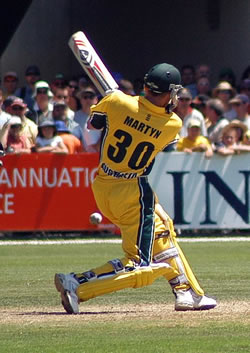A look back at Damien Martyn
Marco Trevisiol |
Australia’s great era of domiance from the mid 1990s to late 200s invariably contained numerous highlights at both a team and individual level. Everywhere you looked there were icons of Australian cricket such as Steve Waugh, Adam Gilchrist, Glenn McGrath and Shane Warne. So many great players were there in this era that some tended to get overlooked despite their significant achievements. One of these is Damien Martyn.
Martyn’s highly successful Test career is remarkable for the fact that for an extended period in the mid 1990s it looked as if he was going to be little more than a footnote in Australian cricket history as a wasted talent.
One of the many exceptional young batting talents that appeared on the Australian domestic scene in the early 1990s, Martyn made such an impression in his performances for Western Australia that he was a shock selection for the opening home Test against the West Indies in 1992/93. He replaced the highly-regarded veteran batsman Dean Jones, in a sign that the selectors thought that new blood like Martyn were what was required to finally beat the West Indies for the first time since the 1970s.
Martyn showed glimpses of talent and class against the high-class West Indies side but overall was only a modest contributor and was on the fringes of the side over the following 12 months. After touring England but not playing any Tests in 1993 he was recalled to the Test side for the 1993/94 home series against South Africa. But this would become a notorious event in his international career as he was largely blamed for humiliating failure to chase a miserly 117 runs for victory.
In many ways the blame Martyn received for this defeat is unfair. In pure statistical terms he was Australia’s second highest run-scorer for the match. And while he played a loose cover drive that saw him dismissed just as Australia were headed for victory, by hanging around and supporting the aggressive batting of tailender Craig McDermott he’d done more than several other more highly-regarded batsmen during the innings. For example in a major error of judgement in the opening over of the final day, none other than Allan Border was bowled not playing a shot. Yet Border’s misjudgement is largely forgotten and it’s Martyn’s dismissal is remembered today.
For a time in the mid-1990s it appeared that Martyn’s talents would go to waste. He not only was failing to press for selection in the Australian Test side, but it looked at one stage as if he would be dropped from the West Australian side. But he got his act together and in the late 1990s returned to the Australian one-day side and by early 2000 had made his return to the Test team. From the start of the 2001 Ashes he was a first-choice selection in the side and for several years became an excellent and essential member of the Test team.
As impressive as his Test record is, citing Martyn’s stats don’t illustrate the appeal of him as a batsman. In an Australian batting side dominated by the brutal hitting domiance of Matthew Hayden, the swashbuckling attack of Adam Gilchrist and the ruthless pulling and hooking of Ricky Ponting, Martyn’s deft stylish strokeplay was a refreshing contrast. There was no player more elegant to watch bat in his era.
He never seemed to extern much effort in his shotmaking, relying more on his exquisite timing to score as heavily as he did. Probably his cut shot was the most appealing and strongest of his shots, so much so that when New Zealand toured in 2001/02 captain Stephen Fleming employed specific tactics to counter Martyn by stacking fielders in the gully/point area. Fleming had some success with this tactic but it was a tribute to Martyn’s skill that opposition captains had to resort to such detailed plans to quell his influence.
The highpoint of Martyn’s Test career was undoubtedly his tours of Sri Lanka and India in 2004. Not just for the runs he scored (four centuries in 7 Tests, plus Man of the Series v India) but in the context these runs were achieved. Up until this time Martyn was widely perceived as an expert player of pace bowling (with his background playing at the WACA) whose Achilles heel was spin bowling. After moderate form during the 2003/04 season, Martyn’s hold on his Test spot wasn’t secure and it was widely assumed that the spin-friendly tracks of Asia would be his permanent undoing. Instead, they were the scene of his greatest triumph as he used deft strokeplay and soft hands to overcome such great spinners like Muttiah Muralitharan and Anil Kumble.
Another great of Martyn as a Test batsman was that not only he was such a regular run-scorer for Australia but he scored runs when his side most needed them. To cite one example in the 2004 Boxing Day Test against Pakistan, Australia were struggling in the face of a Shoaib Akhtar at his fearsome best to the 5/171 in response to Pakistan’s 341. But Martyn held firm and batted with the tail to score 142. His innings was pivotal in turning a difficult situation for Australia into a comfortable victory.
In the 2004-05 period Martyn was at his peak as a Test batsman – graceful, stylish yet full of steel and reliable in a crisis.
By mid-2005 Martyn’s Test batting average was over 51 and it appeared he had many years left in Australia’s Test middle order. Yet by October that year he was out of the Test side. How was this possible?
Obviously it was because of his ordinary 2005 Ashes tour where he only reached 30 once in nine innings. To be sure he was a disappointment in this series but dropping him was a shock move. He was hardly alone amongst the Australian batsmen in struggling that series, he suffered a couple of unlucky dismissals and above all else, his outstanding form in the 15 months previous to that should’ve meant he deserved to be cut a bit of slack.
Perhaps it was easier to drop him because of his unassuming nature as opposed to some of the more dominant personalities in the side who’d been out of form for longer. Whatever the reason it seemed a harsh call.
Despite it appearing the end of the Test road for Martyn he made a surprise return to the side for 6 more Tests against South Africa, Bangladesh and England in 2006. He played one final great innings with a century in the 3rd Test of the South Africa series that helped enable Australia to reach a difficult target of 292 for victory. But overall his performances were underwhelming and he was a shadow of his 2004-05 self.
His ultimate departure from Test cricket in a way summed up Martyn as a personality. In a 2006/07 that saw grand and public farewells for Warne, McGrath and Langer in front of huge crowds. Martyn announced his retirement privately by text message despite being selected for the following Test.
It was a messy and unfortunate way for him to depart the Test scene as someone who’d played 67 Tests, averaged over 46 with 13 centuries and was part of one of the greatest Test sides. But in a way it seemed appropriate for someone who seemed most comfortable out of the spotlight and just let the cricket doing the talking.
And for cricket fans the world over, just watching Damien Martyn bat was more than satisfying.





marto, what a ****ing legend.
Comment by Riggins | 12:00am GMT 16 December 2012
Great read. Always liked Martyn.
Comment by Agent Nationaux | 12:00am GMT 16 December 2012
Loved his retirement “announcement”
Comment by howardj | 12:00am GMT 17 December 2012
one of the best players to watch when on song
Comment by smalishah84 | 12:00am GMT 17 December 2012
Martyn was pure class. Loved watching him play spin.
Comment by CWB304 | 12:00am GMT 17 December 2012